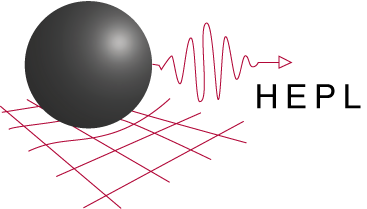News & Events
Preliminary analysis of GP-B data presented
at APS meeting on April 14, 2007
For the past three years a satellite has circled the Earth, collecting data to determine whether two predictions of Albert Einstein's general theory of relativity are correct. Today, at the American Physical Society (APS) meeting in Jacksonville, Fla., Professor Francis Everitt, a Stanford University physicist and principal investigator of the Gravity Probe B (GP-B) Relativity Mission, a collaboration of Stanford, NASA and Lockheed Martin, will provide the first public peek at data that will reveal whether Einstein’s theory has been confirmed by the most sophisticated orbiting laboratory ever created. More
HEPL/KIPAC Seminar
Wednesday, April 25, 2007 4:00pm
Location: Physics/Astrophysics 102/103
Dr. Gregory P. Crawford
Dean of Engineering
Professor of Engineering & Physics
Brown University, Division of Engineering
“In Vivo Spectroscopy for Blood Analyte Monitoring ”
The presentation will focus on the use of diffuse reflectance spectroscopy, in particular some novel liquid crystal based spectrometers and applications in the medical field. One application includes examining the spectral signature of the conjunctiva (lower eyelid) to arrive at an accurate quantitative measurement of total hemoglobin concentration. Other applications include endoscopic identification of problematic blood vessels in the placenta, aging of contusions, and quantification of vascular endothelial leak and proteins associated with inhibition/promotion of this behavior.
Gregory P. Crawford is currently Dean of Engineering and Professor of Engineering and Physics at Brown University. His basic research interests include liquid crystals, polymers, and their application in electro-optic devices for displays, medical devices, telecommunications and integrated optics. He was formally a member of the research staff at Xerox Palo Alto Research Center (PARC) and later dpiX, where he concentrated on liquid crystals and polymers materials for flat panel display applications. In addition to his research at Xerox, he instructed a graduate course on electronic displays at San Jose State University, frequently teaches short courses on flat panel displays at companies, universities and professional conferences, and he has developed a graduate course on flat panel display at Brown University. He received his B.S. in both Physics and Mathematics and a Ph.D. from Kent State University where he performed his doctoral research at the Liquid Crystal Institute and NSF ALCOM Center. He has over 200 research publications, review articles and book chapters, holds 15 US patents, and is the coeditor of the book entitled Liquid Crystals in Complex Geometries formed by Polymer and Porous Networks.
Wednesday, April 25, 2007 4:00pm
Location: Physics/Astrophysics 102/103
Join our HEPL Seminar Mailing list!
Send an email to majordomo@lists.stanford.edu and type
subscribe heplseminars user@stanford.edu
in the body of the message where user@stanford.edu is your email address
You will receive an email confirmation. We hope to see you at a HEPL Seminar soon.
Previous HEPL Seminars 2004, 2005, 2006, 2007:
Professor C.W. Francis Everitt
W.W. Hansen Experimental Physics Laboratory, Stanford University
“Maxwell at 175 ”
Wednesday, March 14, 2007
Paul Brink
Department of Physics, Stanford University speaking for the (Super)CDMS collaboration
“Present status and future plans of the Cryogenic Dark Matter Search (CDMS)”
Wednesday, February 28, 2007
Alfred Vogel
Institute of Biomedical Optics University of Lübeck, Germany
“New findings on plasma and cavity generation in aqueous media with fs and ns laser pulses, and their applications in cell surgery"
Thursday, January 25, 2007
Dr. Dan McCleese
Chief Scientist, Jet Propulsion Laboratory
“Recent Results and Future Direction of the Exploration of Mars"
Tuesday, September 26, 2006
Ned Wright
Professor of Physics and Astronomy, UCLA
What's New in Cosmology?
Thursday 9 March 2006
Peter Michelson
Stanford University
GLAST: The Gamma-ray Large Area Space Telescope Mission
Seminar and Tour
Thursday 16 Feb 2006
Robert L. Byer
Stanford University
"Acceleration of Electrons with Visible Light"
Wednesday 1 Feb 2006
Dr. Nicholas White
Chief,
Laboratory for High Astrophysics NASA Goddard Space Flight Center
“The NASA Beyond Einstein Program”
Wed 5 Oct 2005
Ulrich Schreiber, Forschungseinrichtung Satellitengeodäsie, TU-München
“High Precision Sagnac Interferometry for Applications in Geoscience ”
Thursday, September 8, 2005
Christopher D. Bass,
Indiana University / IUCF, “Measurement of the Parity-Odd Neutron Spin Rotation in Liquid-4He”
Monday, August 22, 2005
Anne Kinney, Director, Universe Division in the Science Mission Directorate, NASA, "Blue Planets, Black Holes"
Wednesday, 20 July 2005
Dr William Tobin, Department of Physics & Astronomy, University of Canterbury, New Zealand, "Foucault's Gyroscope of 1852"
Friday, 8 April 2005
Rex Geveden, NASA Chief Engineer, Independent Technical Authority
7 April 2005
Shooting the Moon: Probing Fundamental Gravity in the Solar System
Tom Murphy,
UC San Diego 3 March 2005
The GRACE Mission: Status and Science Results John Ries, Senior Research Scientist at the Center for Space Research at The University of Texas at Austin, 14 February 2005.
Hubble Robotic Servicing - Recent Engineering Development, Bill Reeve
Civil Space Director of Advanced Science Programs,
Lockheed Martin, 26 January 2005.
Interferometry for LISA, Daniel Shaddock, PhD, Interferometry Metrology and Optics Group, Jet Propulsion Laboratory, 17 November 2004.
The Large Synoptic Survey Telescope (LSST), Steve Kahn, Deputy Director, Kavli Institute for Particle Astrophysics and Cosmology, 27 October 2004.
HEPL-KIPAC Showcase. 29 September 2004. Agenda


